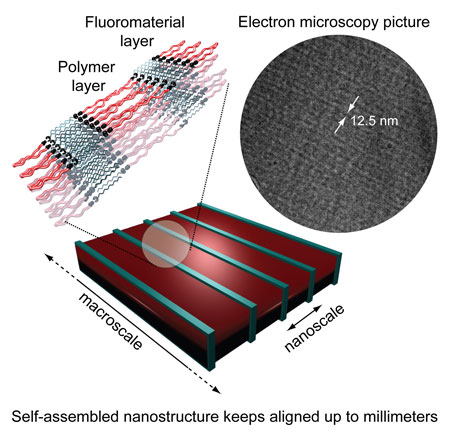| Posted: Jun 04, 2014 |
Molecular self-assembly scales up from nanometers to millimeters
|
|
(Nanowerk News) To ensure the survival of Moore's law and the success of the nanoelectronics industry, alternative patterning techniques that offer advantages beyond conventional top-down patterning are aggressively being explored.
|
|
Can self-assembly based technologies offer advantages beyond conventional top-down lithography approaches?
|
|
A joint effort of the Aalto University of Helsinki, the Politecnico di Milano, and VTT Technical Research Centre of Finland has now demonstrated that it is possible to align molecular self-assemblies from nanometers to millimeters without the intervention of external stimuli ("Halogen-bonded mesogens direct polymer self-assemblies up to millimetre length scale").
|
 |
| Schematics and electron microscopy picture of millimeters aligned self-assembled polymeric nanostructure.
|
|
Molecular self-assembly is a concept derived from Nature that leads to the spontaneous organization of molecules into more complex and functional supramolecular structures. The recipe is "encoded" in the chemical structure of the self-assembling molecules. Molecular self-assembly has been exploited for "templating" functional devices, molecular wires, memory elements, etc. However, it has typically required additional processing steps to achieve extended alignment of the structures.
|
|
The new finding showed that by engineering recognition elements between polymers and fluorinated small molecules, it has been possible to drive their spontaneous self-assembly from nanometers to millimeters, thanks to the judicious use of noncovalent interactions. After the processing, fluoromolecules can optionally be removed upon thermal treatment.
|
|
This concept opens up new avenues in large area nanoconstruction, for example in templating nanowires, which is currently under investigation.
|

